DNA or Deoxyribonucleic Acid is the hereditary material present in all living organisms through which genetic information of one generation is transferred to the next generation.
Simply DNA is the structural & functional unit of heredity.
DNA double helix is probably the most iconic of all biological molecules.
Early Discovery
In the early 1950s, researchers working on Genetics used the term “gene” which means the smallest unit of genetic information. But they did not have an idea of what a gene actually looked like structurally and chemically or how it was transferred from one generation to the next generation.
In 1944 Oswald Avery showed that DNA is the carrier of hereditary information, in Pneumococcal bacteria. Nevertheless, many scientists continued to believe that DNA had a structure too uniform and simple to store genetic information for making complex living organisms. According to scientists, the genetic material must consist of proteins, much more diverse and intricate molecules are known to perform a multitude of biological functions in the cell.
From the work of biochemist Phoebus Levene and other scientists, it was discovered that DNA is composed of subunits called “Nucleotide”.
A Nucleotide is consists of a molecule of Deoxyribose sugar, a Phosphate group & one of the four Nitrogenous bases: Adenine (A), Guanine (G), Thymine (T) & Cytosine (C).
– Here Thymine & Cytosine are called Pyrimidines. They both consist of one ring.
– Adenine & Guanine are called Purines. They both consist of two rings.
DNA nucleotides assemble in chains which are linked by covalent bonds formed between the Deoxyribose sugar of one nucleotide and the Phosphate group of the next nucleotide. This arrangement makes an alternating chain of Deoxyribose sugar and Phosphate groups in the DNA polymer which is known as the sugar-phosphate backbone.
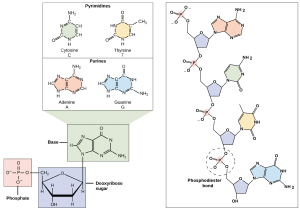
Chargaff’s Rules:
Erwin Chargaff, an Austro-Hungarian biochemist showed that in DNA the number of Guanine units equals the number of Cytosine units and the number of Adenine units equals the number of Thymine units. In human DNA, for example, the four bases are present in these percentages: A=30.9% and T=29.4%; G=19.9% and C=19.8%.
Based on his experiments he proposed
two rules in 1950 that lead to the discovery of the double-helix structure of DNA. These two rules are known as Chargaff’s rules.
These two rules are-
1. In DNA the amount of Adenine is equal to the amount of Thymine
2. In DNA the amount of Guanine is equal to the amount of Cytosine
He also found that the relative amount of nitrogenous bases A, T, G, C varies from organism to organism depending on the composition of DNA.

Rosalind Franklin’s Work On DNA Structure
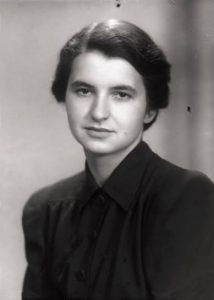
Rosalind Franklin was a British chemist who was an expert in “X-ray Crystallography”, an excellent technique to determine the structure of DNA. In this technique when the crystallized form of a molecule, for example, DNA is exposed to X-rays; some of the rays are deflected by the atoms in the crystal which forms a diffraction pattern that gives clues about the molecule’s structure.
Franklin’s crystallography gave important clues about the structure of DNA. Some of these came from the famous “Image-51” a remarkably clear X-ray diffraction image of DNA. This image was produced by Franklin and her graduate student.
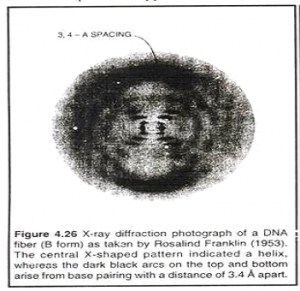

Discovery Of DNA Double Helix Structure By Watson & Crick
In 1953, American biologist James Watson and British physicist Francis Crick came up with their famous DNA double helix model.
Instead of carrying out new experiments Watson and Crick mostly collected and analyzed existing pieces of data from the experiments of other scientists including Franklin, Wilkins and Chargaff and put them together in new ways.
Some of the most important clues of DNA’s structure came from Rosalind Franklin’s work. . Maurice Wilkins showed Watson and Crick the Crystallography data obtained by Rosalind Franklin. The X-ray data confirmed the 3-D structure that Watson and Crick had theorized for DNA. The X-shaped diffraction pattern of Franklin’s image immediately suggested a helical, a two-stranded structure for DNA.
In 1962 James Watson, Francis Crick, and Maurice Wilkins were awarded the Nobel Prize in Medicine for discovering DNA Double Helix Structure. Unfortunately, by then Rosalind Franklin had died due to cancer and Nobel prizes are not awarded posthumously.
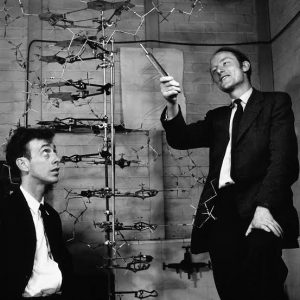
DNA Model Given By Watson & Crick
- DNA is double stranded and an antiparallel molecule which means it is composed of two strands that run alongside each other but are pointed in opposite directions. In a DNA molecule, the 5′ end which is phosphate-bearing of one strand aligns with the 3′ end which is hydroxyl-bearing of its partner and vice versa.
- The two strands of DNA twist around each other forming a right-handed helix.
- The two strands of the DNA double helix are held together by hydrogen bonds between nitrogenous bases (A, T, G, C) on opposite strands. Each pair of bases lies flat, forming a “rung” on the ladder of the DNA molecule.
- In DNA Adenine is paired with Thymine while Guanine is paired with Cytosine. These associations of A-T and G-C are known as complementary base pairs. This base-pairing explains Chargaff’s rules.
- According to Watson & Crick’s model, there are two Hydrogen Bonds between Adenine & Thymine or Guanine & Cytosine. But later scientists found three Hydrogen bonds between Guanine & Cytosine.
- The sugar-phosphate backbones remain on the outside and the core of the helix contains the purine and pyrimidine bases
- The diameter of the DNA is 2 nm. Adjacent bases are separated by 0.34 nm or by 3.4 A along the axis. The length of a complete turn of a helix is 3.4 nm or 34 A.
- The DNA helix has a shallow groove called a minor groove (1.2nm) and a deep groove called a major groove (2.2nm) across.
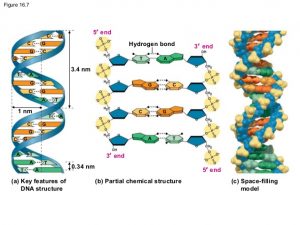
- DNA Double Helix Structure
Some Other Characteristics Of DNA
- DNA can be measured by the unit picogram (1pg= 10 gm)
- The amount of DNA per nucleus is constant in all the somatic cells in a species.
- The total amount of DNA in a haploid genome is a characteristic of each organism which is known as the C-value.
- Only a small fraction of DNA is functional in a eukaryotic cells.
- DNA is the chemical basis of heredity.
- DNA replicates to form DNA and transcribes to form RNA.
- DNA replication is semi-conservative type.
- DNA with a high G + C content are more resistant to thermal melting than A + T rich molecules.
Conclusion
The groundbreaking discovery in 1953 of the double helix structure of Deoxyribonucleic Acid (DNA) by James Watson and Francis Crick marked a milestone in the history of science and gave rise to modern molecular biology. Their discovery yielded ground-breaking insights into the genetic code and protein synthesis which helped to produce new scientific techniques such as recombinant DNA research, genetic engineering, rapid gene sequencing etc.
Revised by
- Md Siddiq Hasan on 29 July 2020
Best safe and secure cloud storage with password protection
Get Envato Elements, Prime Video, Hotstar and Netflix For Free
 Plantlet The Blogging Platform of Department of Botany, University of Dhaka
Plantlet The Blogging Platform of Department of Botany, University of Dhaka
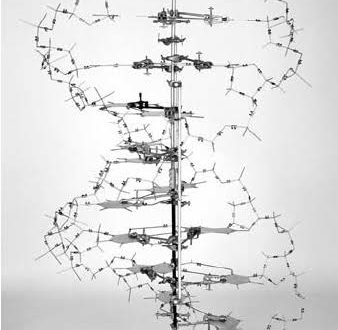



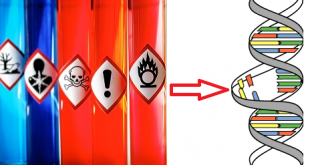
Thanks for shening. I read many of your blog posts, cool, your blog is very good.